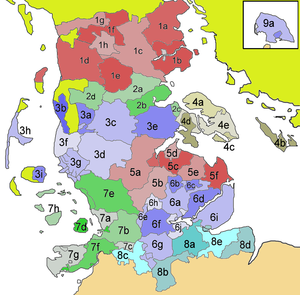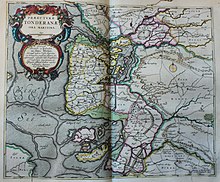Offices and Harden in Schleswig
Offices and Harden in Schleswig were sovereign administrative and judicial districts in the Duchy of Schleswig .
history
The administrative structures can originally be traced back to the higher-level central administration of the sovereigns as well as to the traditional local communities. The early modern administration of the Duchy of Schleswig was divided into four stages:
- The central administration of the Danish king supervised all territories of the crown. Enforcing royal powers against traditional privileges was a long-term process and had to accept setbacks.
- The powers of the provincial administration extended either to the entire duchy of Schleswig or to both duchies of Schleswig and Holstein (and from 1815 Lauenburg) or only to parts of Schleswig, provided that it was divided into several equal principalities.
- The regional administration in the Duchy of Schleswig was divided into offices, but this structure was by no means comprehensive: the nobility and clergy were able to manage their possessions apart from the regional administration. Also excluded were imposed kegs and the so-called landscapes . Places with city rights were also outside of the administrative structure. Offices and landscapes were also divided into Harden ; spiritual areas consisted of bailiwicks with a varying degree of independence. Parishes took on many tasks, but their boundaries often did not coincide with the higher-level units.
- The grown village structures formed the fourth local level, the basis of the entire system. The boundaries of the local units remained largely unchanged. In the extreme case, a village fell into seven different jurisdictions that had local jurisdiction .
Offices
The conception of the office as a sovereign administrative district developed in the Old German Empire . First the offices were established in Holstein and then in the 15th and 16th centuries in Schleswig. In the Kingdom of Denmark, the office structure was only introduced after 1661/62 (see also the administrative structure of Denmark ). From the 16th to the 19th century, the offices formed the most important elements of the regional administration.
Their forerunners were the fiefdoms that arose around sovereign castles . Syssel existed in earlier times . However, they never developed into fixed administrative and legal units and cannot be viewed as a preliminary stage to the fiefdom. The Syssel probably originated in the 9th to 10th centuries. They disappeared again in the Middle Ages . The reasons for this cannot be conclusively clarified - the fiefs could have ousted the Syssel in the 14th century, because their military function was of great interest to the sovereign. The transition between feudal and official structures was fluid in Schleswig. By 1850, the offices finally made up around two thirds of the duchy. But critics like Otto von Blome have already called for their abolition and a regional administrative reform based on the landscape as a model.
Harden
Harden ( herred in Danish ) were lower administrative units and judicial districts. They emerged after the end of the Viking Age and originally only outlined a settlement area. According to the Waldemar-Erdbuch of 1231, North Friesland was divided into thirteen hundred groups that bore the name Harde. Each harde was calculated with 100 bonds ( free farmers ).
Several Harden were subordinate to one office. They lost their jurisdiction in the course of the unbundling of the judiciary and administration after the formation of the Prussian province Schleswig-Holstein in 1867. They were replaced by the Hardesvogtei districts, in 1888 they were finally dissolved and replaced by smaller districts. The name Harde lives on to this day in North Frisian landscape names such as Wiedingharde , Karrharde and Goesharde .
Property districts
In 1853 an administrative reform took place, which abolished the remaining estate districts. This administrative structure came to an end after the Prussian province of Schleswig-Holstein was founded in 1867.
listing
List of German and - in italics - Danish names according to the map from 1836:
Office Hadersleben Haderslev Office
- 1a Tyrstrupharde Tyrstrup Herred
- 1b Hadersleben Harde Haderslev Herred
- 1c Grammharde Gram Herred
- 1d Hvidingharde Hviding Herred
- 1e Norderrangstrupharde Nørre Rangstrup Herred
- 1f Frösharde Frøs Herred
- 1g Kalslundharde Kalvslund Herred
- 1h gram and Nybel goods Gram og Nybøl godser
- City of Hadersleben Købstaden Haderslev
Aabenraa and Lügumkloster Aabenraa og Løgumkloster Amter
- 2a Süderrangstrupharde Sønder Rangstrup Herred
- 2b Riesharde Rise Herred
- 2c Warnitz Birk Varnæs Birk
- 2d Lügumkloster Birk Løgumkloster Birk with spots Lügumkloster Løgumkloster
- City of Aabenraa Købstaden Aabenraa
Amt Tondern Tønder Amt
- 3a Tonderharde Tønder Herred
- 3b Hoyerharde Højer Herred with spots Hoyer Højer
- 3c Schluxharde Slogs Herred
- 3d Karrharde Kær Herred
- 3e Lundtoftharde Lundtoft Herred
- 3f Wiedingharde Vidding Herred Wiringhiird
- 3g Bökingharde Bøking Herred Böökinghiird
- 3h landscape Sylt Landskabet Sild
- 3i landscape Osterland-Föhr Landskabet Østerland Før with spots Wyk Vyk
- City of Tondern Købstaden Tønder
Offices Norburg and Sonderburg Nordborg og Sønderborg Offices
- 4a Alsener Norderharde Als Nørre Herred with Flecken Norburg Nordborg
- 4b Ærø Harde Ærø Herred with Marstal
- 4c Alsener Süderharde Als Sønder Herred
- 4d Nübelharde Nybøl Herred
- 4th Augustenborg estates Augustenborgske godser
- Cities Sønderborg and Ærøskøbing Købstæderne Sønderborg og Ærøskøbing
Flensburg Office Flensborg Office
- 5a Wiesharde Vis Herred
- 5b Uggelharde Ugle Herred
- 5c Husbyharde Husby Herred
- 5d Munkbrarupharde Munkbrarup Herred
- 5e Nieharde Ny Herred
- 5f Angeliter Güterdistrikt Angler Godsdistrikt (after 1853 Kappelner Harde Kappel Herred )
- City of Flensburg Købstaden Flensborg
Office Gottorf Gottorp Office
- 6a Struxdorfharde Strukstrup Herred
- 6b Satrupharde Satrup Herred
- 6c Mohrkirchharde Mårkær Herred
- 6d Schliesharde and Füsingharde Slis og Fysing Herred
- 6e Treiaharde Treja Herred
- 6f Arensharde Arns Herred
- 6g Kroppharde Krop Herred
- 6h Vogtei Bollingstedt Fogderiet Bollingsted
- 6i Schwansens goods district Svansens aristocratic district on the Schwansen peninsula (in the Middle Ages Riesebyharde Risby Herred )
- 6j Johannis Klosterdistrikt Johannis Klosters Distrikt
- Angeliter Güterdistrikt Angler Godsdistrikt (after 1853 Kappelner Harde Kappel Herred )
- City of Schleswig Købstaden Slesvig
Offices Husum and Bredstedt Husum og Bredsted Amter
- 7a Norderharde Husum Nørre Herred (in the Middle Ages Nordergoesharde Nørre Gøs Herred )
- 7b Süderharde Husum Sønder Herred (in the Middle Ages Südergoesharde Sønder Gøs Herred )
- 7c Vogtei Schwabstedt and Rödemis Fogderiet Svavsted og Rødemis with spots Schwabstedt
- 7d landscape north beach Landskabet north beach
- 7e landscape Bredstedt Landskabet Bredsted with spots Bredstedt (in the Middle Ages Nordergoesharde Nørre Gøs Herred )
- 7f Eiderstedt landscape, eastern part of Landskabet Ejdersted
- 7g landscape Eiderstedt western part Landskabet Ejdersted
- 7h landscape Pellworm Landskabet Pelvorm
- Towns of Husum , Tönning and Garding Købstæderne Husum, Tønning and Garding
Ämter Hütten und Stapelholm Hytten Amt og Stabelholm Amter
- 8a Hüttener Harde Hytten Herred
- 8b Hohner Harde (also Sorgeharde or Kampharde) Hohn Herred, Sorg Herred eller Kamp Herred
- 8c Landscape Stapelholm Landskabet Stabelholm
- 8d 1st manor district Danish Wohld Godsdistrict Jernved
- 8e 2nd manor district Danish Wohld Godsdistrikt Jernved
- Cities Friedrichstadt and Eckernförde Købstæderne Frederiksstad og Egernførde
Office Fehmarn Femern Office
- 9a Fehmarn landscape with Petersdorf
- City castle .
See also
Flecken , Oktroy , Birk (district)
literature
- Gerret Liebing Schlaber: Hertugdømmet Slesvigs forvaltning. Administrative structures and retspleje mellem Ejderen and Kongeåen approx. 1460-1864 , ed. from the study department of the Danish Central Library for South Schleswig, Flensburg 2007. ISBN 978-87-89178-65-3
- Otto von Blohme: About community being. With special consideration for the duchies of Schleswig and Holstein . Perthes & Besser, Hamburg 1832
Individual evidence
- ↑ Lemmata Amt u. Harde. In: Klaus-Joachim Lorenzen-Schmidt , Ortwin Pelc (Ed.): Schleswig-Holstein Lexikon . 2nd edition, Wachholtz, Neumünster, 2006.
- ^ Gerret Liebing Schlaber: Hertugdømmet Slesvigs forvaltning. Administrative structures and retspleje mellem Ejderen and Kongeåen approx. 1460-1864 , Flensburg 2007, p. 18 f.
- ↑ Liebing Schlaber, Hertugdømmet Slesvigs forvaltning , pp. 143-179
- ^ Liebing Schlaber, Hertugdømmet Slesvigs forvaltning , p. 19
- ↑ Klaus-Joachim Lorenzen-Schmidt, Ortwin Pelc (Ed.): The new Schleswig-Holstein Lexicon. Wachholtz, Neumünster 2006, Lemma Amt.
- ^ Liebing Schlaber, Hertugdømmet Slesvigs forvaltning , p. 147
- ^ Liebing Schlaber, Hertugdømmet Slesvigs forvaltning , p. 143
- ^ Otto von Blohme: Ueber Gemeindewesen. With special consideration for the duchies of Schleswig and Holstein . Perthes & Besser, Hamburg 1832
- ^ Lorenzen-Schmidt / Pelc, Schleswig-Holstein Lexicon
- ↑ Helmut Hess: Chronicle of Uelvesbüll . Municipality of Uelvesbüll, 1985, p. 13f.

